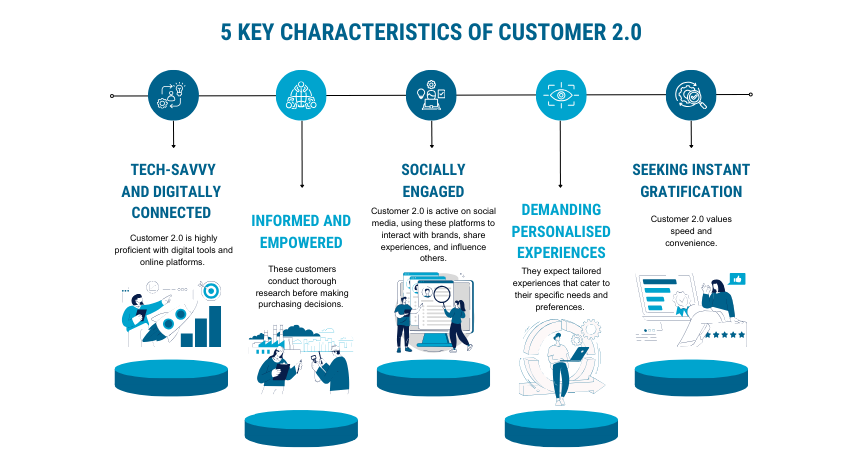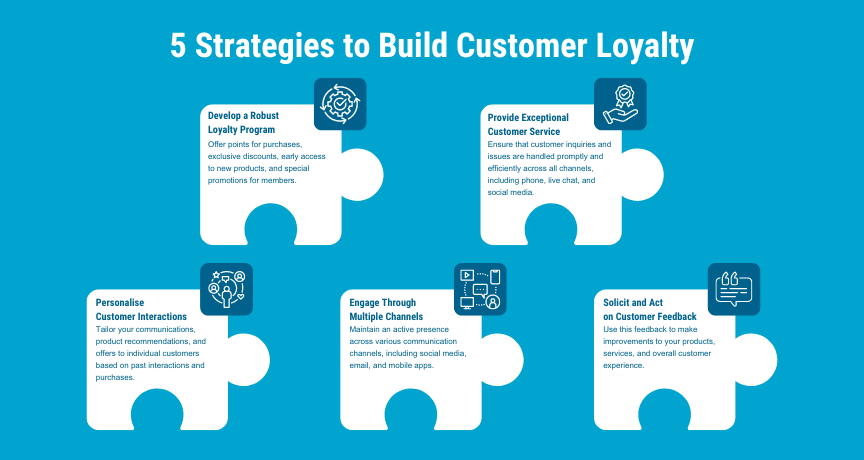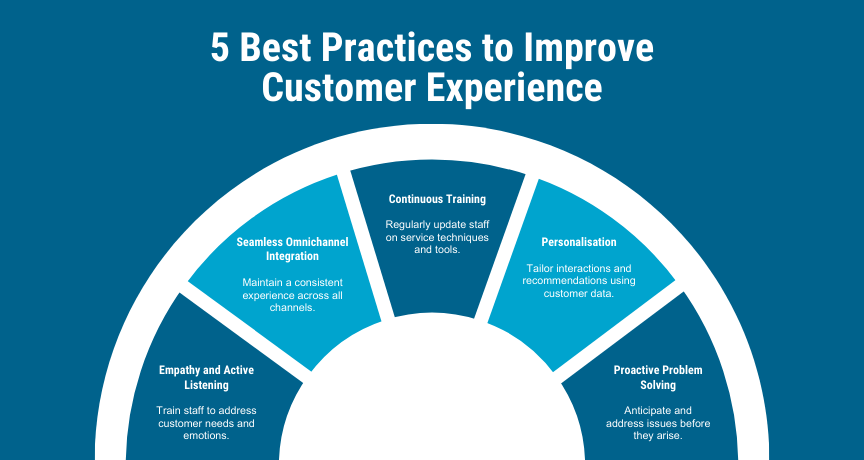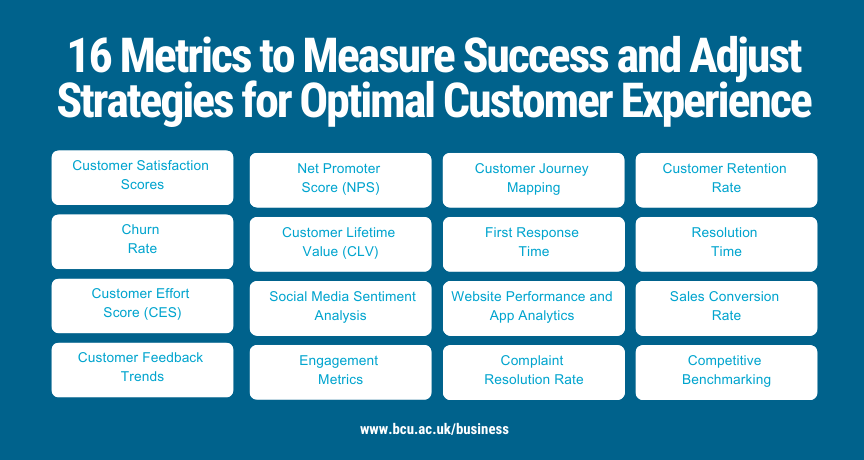It is worth noting that a significant majority, specifically 86% of buyers, have expressed their willingness to pay a higher price in exchange for a superior customer experience (CX). This striking statistic emphasises a notable change in customer expectations and highlights the crucial role of customer experience (CX) in driving business success.
It is a fact that customer preferences have shifted towards valuing exceptional experiences more than just price and product. This means that companies need to adapt and evolve in order to stay relevant and avoid being left behind.
In this article, we will explore practical strategies that can help you safeguard your customer experience (CX) and ensure the success of your business in a dynamic and evolving market. Businesses can secure their long-term success by consistently delivering excellent experiences to customers through the use of these tactics.
Understanding the Evolving Customer Landscape
Future-proofing your customer experience is anticipating and planning for your customers’ evolving needs and preferences throughout their entire customer journey. This approach prioritises adopting new technology, maintaining up-to-date with industry trends, and continuously improving strategies to exceed client expectations.

Introduction to the Modern Customer (Customer 2.0)
The digital revolution has transformed the way customers interact with businesses. Today’s customers, often referred to as “Customer 2.0,” are not the same as those from a decade ago. They are more connected, more informed, and more demanding. Understanding these interactions through a customer journey map is crucial for visualising and optimizing the customer's experience.
They expect personalised experiences and instant gratification. They are not just passive consumers; they are active participants in the buying process.
Now, let’s take a closer look at the characteristics, statistics, and implications of this emerging group of customers.
Characteristics
- Tech-Savvy: Customers possess a deep understanding of digital tools and online platforms, showcasing their tech-savviness. Consumers are adept at leveraging technology to elevate their shopping experience.
- Informed: These individuals actively engage with brands on multiple social media platforms and place a high importance on transparency and meaningful interactions. Brands that are responsive and authentic on these platforms are highly valued by users.
- Socially Engaged: These individuals actively engage with brands on multiple social media platforms and place a high importance on transparency and meaningful interactions. Brands that are responsive and authentic on these platforms are highly valued by users.
Statistics
- 93% of Buyers Start with an Internet Search: This underscores the importance of a strong online presence. Customers increasingly rely on digital channels for information and initial interactions.
Implications
Strong Online Presence: Businesses must invest in effective digital marketing strategies and maintain a consistent online presence to capture potential customers early in their buying journey.
Digital Engagement: In order to increase your brand's online presence, it is essential for your business to maintain an active presence on relevant digital platforms. This includes consistently sharing valuable content and promptly addressing customer inquiries and concerns. By doing so, you can effectively engage with your audience and build a strong online reputation.
Changing Expectations
Customer 2.0 has come to expect more than just a mere product or service. Their interactions with innovative, digital-first businesses have shaped their customer experience expectations.
This type of customers are in search of a comprehensive experience that addresses their unique requirements and personal preferences.
The changing expectations have significant implications for businesses when it comes to their customer interactions, necessitating a robust customer experience strategy to deliver a positive, valuable, and differentiated experience at every touchpoint.
Statistics
- 86% of Buyers Willing to Pay More for a Great Customer Experience: This statistic reflects a significant shift in consumer behaviour. It emphasises that customer experience has become a decisive factor in purchasing decisions, often outweighing other considerations like price or product features.
Focus
From Product and Price to Experience: Customer 2.0 values seamless, personalised experiences over product features and prices. They anticipate a high level of convenience, personalisation, and emotional connection from brands. This transformation needs a change in corporate strategies, with a greater emphasis on providing memorable client experiences.
Personalised Interactions: In a competitive market, personalisation can be a significant differentiation. Businesses must adjust their offerings and communication to each customer's specific needs and preferences. This could include personalised product suggestions, targeted marketing initiatives, or tailored customer service encounters.
Impact of Digital Transformation
In the era of digitalization, a profound wave of change has swept through the business landscape, leaving no aspect untouched.
The rapid advancements in technology have brought about a transformation that goes beyond just changing how businesses operate. It has also had a significant impact on customer expectations.
Technological Advancements
- How Digital Tools Have Changed Expectations: Technological advancements, including AI, chatbots, and mobile apps, have altered customer service and interaction. Customer 2.0 has come to expect nothing less than immediate responses, personalised recommendations, and a seamless digital experience.
Adaptation
- Evolving with Technological and Behavioural Shifts: Businesses must constantly adapt to technological breakthroughs and changing customer behaviours. This includes investing in new technologies, upgrading digital tactics, and keeping up with industry trends. It is not enough to simply use advanced technology; you must also grasp how these technologies can enhance consumer experiences and promote corporate success.
Key Strategies to Future-Proof Customer Experience
Ensuring that your customer experience management remains at the forefront of innovation and relevance is pivotal for the success of your business.
In this section, we will discuss essential strategies that can help you effectively align your customer experience with the evolving needs of today’s consumers.
Every strategy is backed by practical methods designed to achieve long-term success.

Proactive Communication
Importance: Anticipating customer needs and proactively staying in touch plays an essential role in reinforcing a brand's commitment to its customers.
By being proactive, businesses can address issues and answer questions before they even arise, demonstrating their dedication to providing excellent customer service.
Regular Updates
Inform clients of any new offerings or changes to the business.
Keep your audience informed and engaged with your brand with email newsletters, social media posts, and push notifications.
Personalised Messaging
Use client information to create one-of-a-kind messages.
Personalised product suggestions based on previous purchases, birthday discounts, and early access to new product releases are just a few examples.
Personalising messages shows that you care about each consumer and encourages them to engage more.
Multi-Channel Engagement
Maintain a consistent presence across various communication channels such as social media, email, and live chat. Ensure that your team is equipped to engage with customers across these platforms, providing user-friendly and integrated interactions.
Listening and Responding to Customer Feedback
Actively listening to and collecting customer feedback is extremely important for continuous improvement.
Feedback provides insights into customer experiences, highlights areas for enhancement, and helps build stronger relationships.
Customer Surveys
Conduct surveys on an ongoing basis to collect feedback regarding product performance, service quality, and customer satisfaction. Take advantage of these insights to monitor fluctuations in customer expectations and identify areas for improvement.
Social Listening
Monitor social media and online forums for mentions of your brand. Employ social listening tools to track sentiment, identify emerging issues, and engage with customers in real-time. This provides a pulse on public perception and can inform proactive responses.
Feedback Loops
Establish mechanisms to accumulate and evaluate feedback on an ongoing basis. Establish mechanisms to facilitate the closure of the cycle with customers by demonstrating how their input has resulted in actionable modifications. This illustrates your dedication to improvement and your appreciation for their perspectives.
Personalisation and customisation
Importance: Customising experiences to cater to the unique needs of each customer plays an important role in ensuring their satisfaction and building long-term loyalty.
By gaining a comprehensive understanding of the distinct preferences and behaviours exhibited by individual customers, businesses have the opportunity to craft personalised interactions that strike a chord on a profound level.
Not only does this lead to a more captivating experience, but it also gives customers a sense of being valued and understood.
In addition, by utilising data analytics and feedback, companies can constantly improve their offerings, guaranteeing that they stay up-to-date and attractive to customers.
When customers develop a deep affinity for a brand, they are more likely to continue doing business with it, resulting in improved customer retention and a strong brand reputation.
Tailored Offers
Use insights from customer data to create personalised offers and promotions. This can include special discounts based on purchase history or exclusive deals for high-value customers. Tailored offers make customers feel valued and increase engagement.
Personalised Marketing
Segment your audience based on behaviours, preferences, and demographics. Develop targeted marketing campaigns that address the specific interests and needs of these segments, thereby increasing the relevance and effectiveness of your messaging.
Data-Driven Interactions
Use advanced data analytics to better understand customer behaviour and anticipate future demands. Use this information to make relevant recommendations and offer proactive support, ensuring that each connection is valuable and personalised.
Delivering Consistent Multi-Channel Customer Journey Experiences
Importance: Consistency across all customer touchpoints is absolutely crucial for maintaining a coherent and positive brand experience.
This consistency helps to build trust and loyalty among customers, as they can rely on a consistent experience no matter where or how they engage with the brand.
Additionally, measuring the customer effort score (CES) is important to understand the ease of customer interactions and to track improvements in customer experience over time.
Consistent Branding
Ensure that your brand’s visual identity, messaging, and tone are uniform across all customer interactions. Consistent branding builds recognition and trust, making your brand more memorable.
Integrated Customer Support
Provide a unified support experience by integrating various customer service channels, such as phone, email, live chat, and social media. This ensures that customers receive consistent assistance, regardless of the platform they use.
Synchronised Online/Offline Experiences
Align online promotions, product information, and customer service with in-store experiences. This creates a cohesive brand journey, whether customers are interacting with your brand online or in person.
Enhancing Customer Support and Service
Effective customer support is a cornerstone of a positive customer experience. Training customer service representatives to handle inquiries efficiently is crucial for providing personalised interactions, seamless access to information, clear communication, and timely responses.
High-quality support mechanisms are essential for resolving issues quickly and satisfactorily.
Team Training
Regularly train your customer service representatives to handle inquiries efficiently and professionally.
Equip them with the skills and knowledge needed to address a wide range of customer issues and maintain high service standards.
Self-Service Options
Provide self-service options to enhance customer experience, including a wide range of frequently asked questions, extensive knowledge bases, and efficient automated chatbots.
These resources empower customers to discover solutions on their own, alleviating the burden on your support team and enhancing overall efficiency.
Quick Response Times
Make it a priority to quickly respond to customer enquiries and resolve any issues they may have.
Developing effective systems to track and manage response times is crucial in ensuring prompt resolutions, which ultimately leads to enhanced customer satisfaction and prevents frustration.
Building Customer Loyalty and Relationships
Absolutely, developing and sustaining great customer relationships is indeed fundamental to business success.
Reducing customer churn through effective loyalty programs is crucial, as it is more costly to acquire a new customer than to keep an existing one. Here are a couple of examples of strategies your business can implement to enhance customer relationships:
Loyalty Programmes
Create and execute loyalty programs that incentivise customers to make repeat purchases and actively engage with your brand.
Providing attractive incentives like discounts, points, or exclusive access can effectively encourage ongoing loyalty and reinforce positive behaviour.
Personalised Follow-Ups
It is important to follow up with customers after significant interactions or purchases to personalise their experience and make sure they are satisfied.
Personalised follow-ups show that you care about their experience and provide opportunities to address any additional needs or concerns.
Rewarding Loyal Customers
Recognising and rewarding loyal customers with special perks or acknowledgements can be a highly effective way to show appreciation for their continued support.
By offering early access to new products, special discounts, and exclusive invitations to events, you can strengthen their connection to your brand.
Adapting to Emerging Trends and Technologies
Keeping up to date with industry advancements allows you to anticipate market shifts and respond quickly to changing demands. This agility is make-or-break in an era where customer preferences can shift rapidly.
Data analytics and customer feedback will help you improve your planning and execution and produce highly focused marketing campaigns exclusively intended for your audience.
Investing in AI
Integrating AI technologies can be a game-changer for businesses, allowing them to streamline processes, personalise interactions, and significantly improve efficiency.
By investing in AI, companies may benefit from the power of advanced algorithms and machine learning to refine their operations and deliver a more tailored experience to their customers.
Exploring AR/VR
When it comes to creating immersive customer experiences, using augmented reality (AR) and virtual reality (VR) can help businesses stand out from the competition and engage customers in unique ways.
These technologies can provide interactive and memorable experiences that can increase brand loyalty and drive sales.

Best Practices for Implementing Future-Proof Strategies
To ensure long-term success and drive continuous improvement, it is worthwhile to adopt and deeply embed future-proof customer experience strategies, including customer relationship management (CRM), within your organisation.
Customer-Centric Culture
It is essential to instill a culture that is centred on the customer in order to conform the principles and procedures of your company to the requirements of your clientele.
Training programs for employees, especially the customer support team, are crucial in understanding customer personas and providing better service.
This culture ensures that every member of the team places a high priority on the achievement of customer satisfaction and makes a contribution to a great experience.
Employee Training
Create all-encompassing training programmes that place an emphasis on the significance of providing a positive experience for customers.
In addition to providing employees with the skills necessary to effectively manage a variety of client contacts, it is important to educate employees on how their responsibilities impact the happiness of customers.
Incorporate scenario-based training in order to address difficulties that are encountered in real life and to reinforce effective practices.
Customer-Centric Policies
Creating and enforcing policies that demonstrate a commitment to the requirements of customers is at the heart of customer-centric policies.
To do this, it may be necessary to implement return policies that are flexible, personalised service alternatives, and procedures that prioritise the prompt resolution of consumer complaints.
Leadership Commitment
Incorporate a customer-centric approach into the company's mission and values in order to demonstrate the leadership's commitment to creating a customer-centric strategy.

Continuous Improvement and Innovation
Sustained enhancement and uniqueness are crucial for maintaining competitiveness and satisfying ever-changing customer demands.
Regularly updating processes to focus on the entire customer journey allows you to adapt to changes, refine processes, and seize new opportunities to improve the customer experience.
Regularly Updating Processes
Implement a structured approach to process improvement, such as Six Sigma or Lean methodologies. Regularly review and refine customer experience processes to address emerging needs and challenges.
Encourage teams to propose and test new ideas for enhancing service delivery, and use data-driven insights to guide these updates.
Embracing Feedback
Foster a culture that actively seeks and values feedback from customers, employees, and other stakeholders.
Use customer feedback to identify areas for improvement and drive innovation. Create feedback loops that enable quick implementation of changes and communicate improvements to customers to reinforce their value.
Staying Informed About Industry Trends
Participate in industry conferences, subscribe to relevant publications, and engage with thought leaders to stay informed.
Implement these insights to anticipate future trends and proactively adapt your strategies to remain relevant and innovative.
Measuring Success and Adjusting Strategies
Measuring the effectiveness of customer experience strategies is fundamental to understanding their impact and making informed adjustments.
Metrics and KPIs provide valuable insights into performance, enabling organisations to refine strategies and drive continuous improvement.

Tracking Customer Satisfaction
Implement systems to regularly measure customer satisfaction through surveys, feedback forms, and other tools.
Analyse satisfaction scores to gauge how well your strategies are meeting customer needs and expectations. Use this data to identify strengths and areas for improvement, and adjust strategies accordingly.
Monitoring Net Promoter Score (NPS)
Track your Net Promoter Score (NPS) to assess customer loyalty and the likelihood of recommendations.
NPS provides insights into overall customer sentiment and can highlight areas where your customer experience may be falling short. Use NPS data to pinpoint and address issues that could impact customer advocacy and retention.
Analysing Customer Journeys
Map and analyse customer journeys to understand how customers interact with your brand at various touchpoints.
Identify pain points, bottlenecks, and opportunities for enhancement within these journeys.
Use journey analytics to inform strategy adjustments and ensure a seamless and positive experience throughout the customer lifecycle.
Future Outlook
The business landscape is constantly evolving, necessitating adaptability and flexibility. Technological advancements and changing customer expectations drive these changes.
A proactive approach ensures a relevant, engaging, and competitive customer experience. By refining strategies and embracing new opportunities, businesses can thrive and secure long-term success.
Interested in improving your customer experience? The Knowledge Transfer Partnership (KTP) programme offers a unique opportunity for businesses to innovate, grow, and focus on the customer, leading the way in market changes.
Contact us today to start your journey towards sustainable growth and success.






